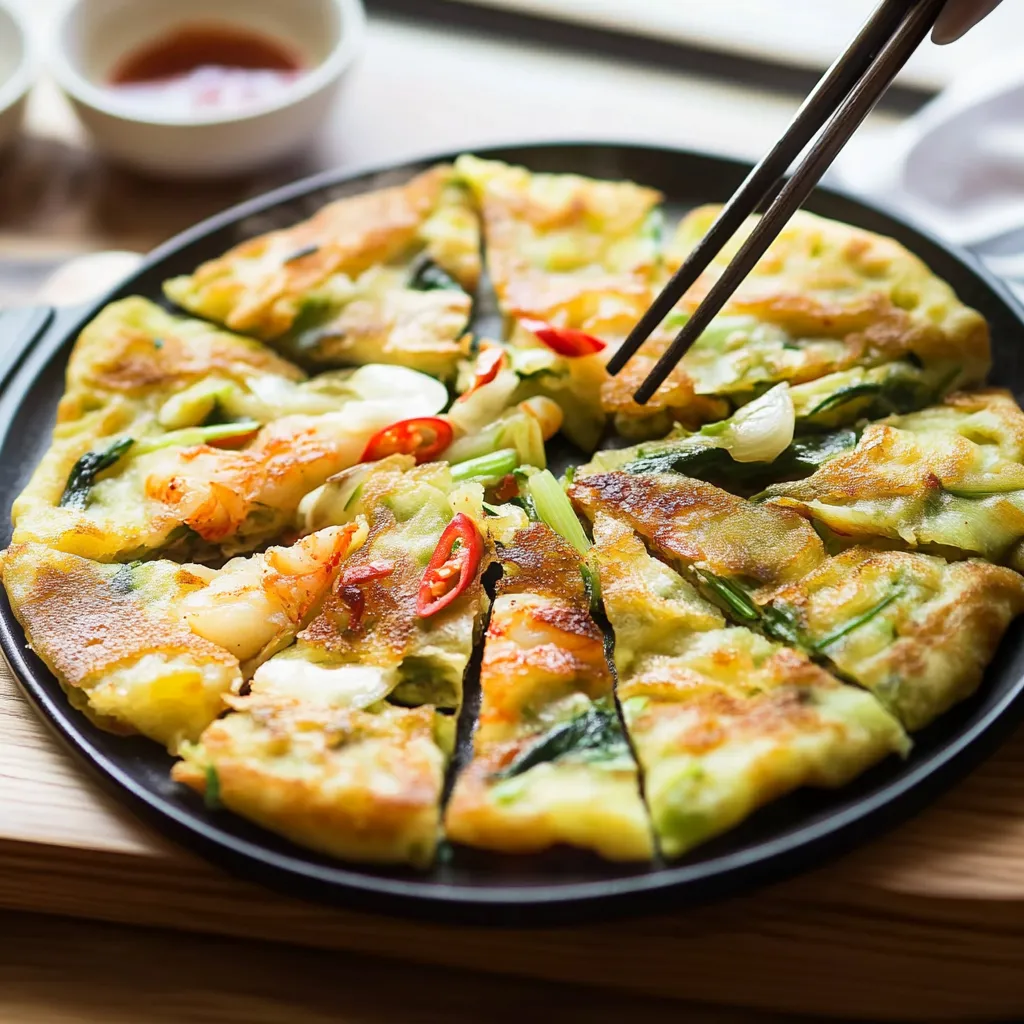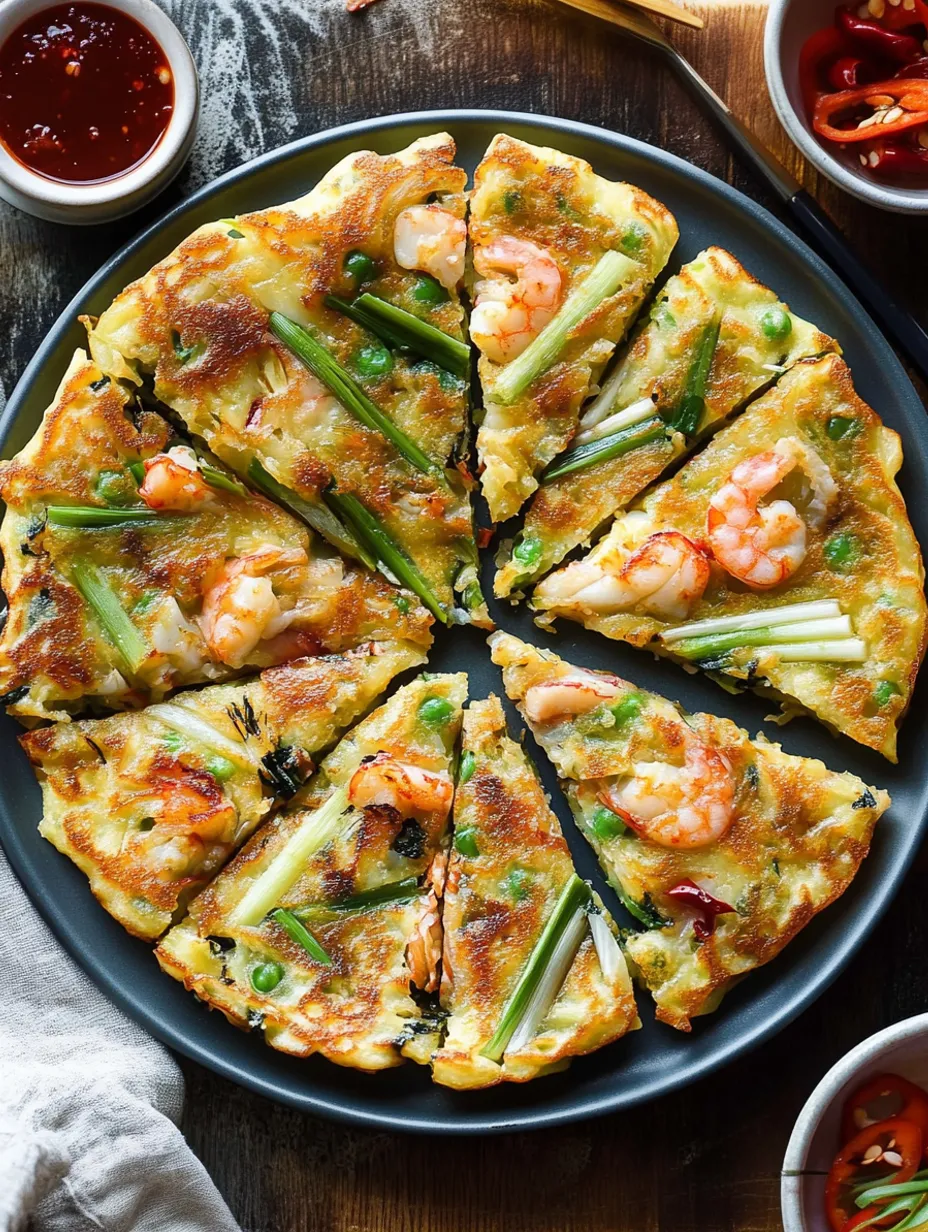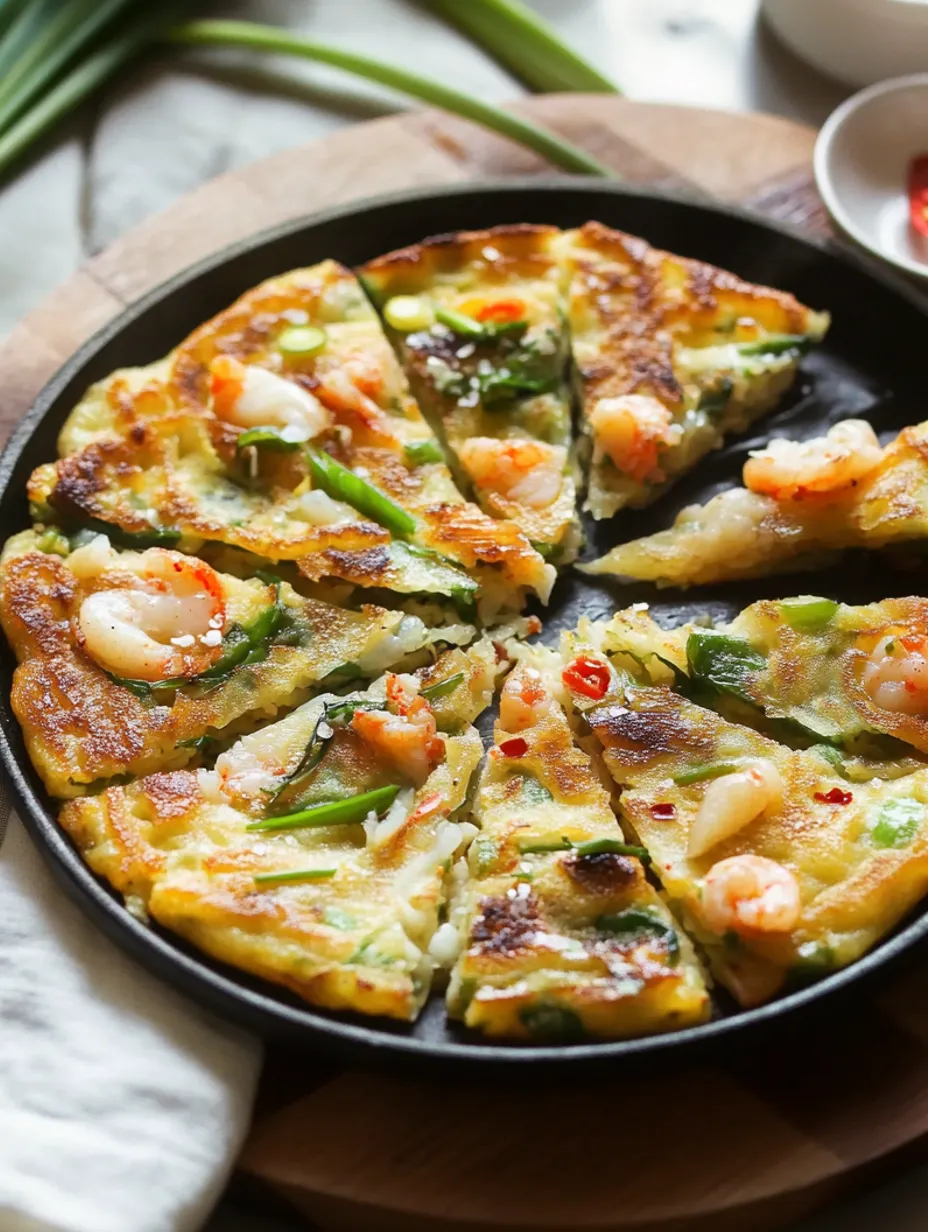 Pin it
Pin it
Korean seafood pancake knocked my socks off the first time I tried it at a tiny restaurant tucked away in my city's Koreatown. This crispy-chewy pancake bursts with fresh scallions and tender seafood pieces that create the perfect savory bite. The best part? You can whip up restaurant-quality haemul pajeon at home in under 15 minutes using pantry staples and frozen seafood. One bite of this umami-packed dish will transport you straight to the streets of Seoul.
I became obsessed with perfecting this recipe after a rainy weekend in Korea where I ducked into a small eatery to escape a downpour. The owner explained that Koreans traditionally enjoy pajeon with makgeolli (rice wine) on rainy days—something about the sizzle of the pancake mimicking rainfall. Back home, I spent weeks testing different batters until I nailed that perfect balance between crispy edges and chewy center. My Korean neighbor finally gave it her stamp of approval last spring, which felt like winning a culinary gold medal.
Flavor Builders
Korean pancake mix contains the perfect blend of seasonings and leavening agents that create authentic flavor and texture impossible to replicate with plain flour.
Tempura mix provides that magical crispy exterior while keeping the inside tender—the secret weapon most home cooks miss.
Ice-cold water creates steam pockets when it hits hot oil, resulting in that coveted crispy-chewy texture that makes restaurant versions so addictive.
Fresh scallions form the backbone of flavor, adding bright, oniony notes that balance the richness of the seafood.
I learned the hard way about the importance of quality pancake mix after a disappointing attempt using regular flour. The authentic Korean mix has subtle seasonings already incorporated—garlic, salt, and sometimes dried seafood powder—that build layers of flavor impossible to recreate from scratch. Now I keep both pancake and tempura mix in my pantry at all times for pancake emergencies (which happen more frequently than I'd like to admit).
 Pin it
Pin it
Cooking Process
Prepare The BatterMix ¾ cup Korean pancake mix and ¾ cup tempura flour in a large bowl. Pour in about 1 ½ cups ice-cold water gradually while whisking until you reach a consistency similar to thick cream soup. Keep a measuring cup of water in the freezer for about 10 minutes before mixing.
Prep Your SeafoodThaw about 1 cup of frozen seafood mix (calamari, shrimp, mussels) quickly by submerging sealed packages in cold water for about five minutes. Pat calamari and shrimp completely dry with paper towels. Cut calamari rings into bite-sized pieces if they're large. Devein shrimp if needed.
Scallion MagicCut one full bunch of green onions into thirds lengthwise, then crosswise into approximately three-inch segments. Arrange scallion pieces so they're somewhat parallel when adding to the batter.
Hot Pan TechniqueHeat a 10-inch non-stick skillet over medium-high heat until a drop of water sizzles instantly upon contact. Pour in about 3 tablespoons of vegetable oil. Ladle the batter-seafood-scallion mixture into the center of the pan, using the back of the ladle to spread it into a circle about ½-inch thick. Drizzle additional oil around the edges.
Perfect FlipCook until the bottom develops a golden-brown crust, about 3-4 minutes. The edges should look set but the center will still be slightly wet. Slide a wide spatula completely under the pancake, lift slightly to check color, then quickly flip with confidence. Press down gently with the spatula to ensure even cooking, and add a splash more oil around the edges for maximum crispiness.
My father-in-law visited Korea during his military service in the 1970s and still talks about these pancakes fifty years later. When I made this recipe for him last Christmas, he got quiet, took a bite, and then told everyone at the table about eating these from street vendors during monsoon season. Food memory is powerful stuff. Now my kids request "grandpa's rainy day pancakes" whenever the forecast shows storms, continuing this strangely comforting tradition connecting food with weather.
Serving Suggestions
Slice your crispy pancake into manageable squares or triangles before bringing it to the table. Always serve with the traditional dipping sauce (recipe below) in small individual bowls. For a complete meal, I pair it with a simple bowl of steamed rice and kimchi. When entertaining, I make several smaller pancakes rather than one large one.
Pancake Variations
Switch up your seafood selection based on what looks fresh—sometimes I use only squid when it's particularly good at the market. For a budget version, use canned tuna mixed with a bit of sesame oil instead of fresh seafood. Vegetarians in my family love this with thinly sliced mushrooms and zucchini in place of seafood. For extra color and nutrition, I occasionally add julienned carrots or thinly sliced red bell pepper. During spring, fresh fava beans make a surprising but delicious addition that my Korean friends approve of.
Leftover Love
Store any leftover pancake in the refrigerator, tightly wrapped in foil or plastic wrap, where it keeps beautifully for up to two days. Reheat in a dry skillet over medium heat for about two minutes per side to restore crispiness—microwaving will make it disappointingly soggy. I sometimes chop cold leftover pancake into bite-sized pieces and add them to simple broth for a quick breakfast soup. For the ultimate next-day upgrade, top reheated pancake pieces with a fried egg and drizzle with extra dipping sauce.
 Pin it
Pin it
Chef Insights
Don't overmix the batter once you add the seafood and scallions—a few gentle folds preserve texture and prevent the release of too much moisture. Listen for the sizzle to gauge proper cooking temperature—if it goes silent, your pan isn't hot enough; if it's too loud with popping, lower the heat slightly. Rest your pancake for one minute after cooking before cutting—this brief pause allows the interior to set properly while maintaining the crisp exterior.
My first attempt at this pancake was a soggy disaster because I feared using too much oil. Korean cooking taught me that proper fat is essential for texture development—not just for flavor. This pancake has become my go-to dish when I want to impress friends with minimal effort. The looks on their faces when that golden-brown disk hits the table makes me smile every time. There's something magical about transforming simple ingredients into something that brings such immediate joy to everyone at the table.
Traditional Dipping Sauce
Soy Sauce - 2 tablespoons.
Rice Vinegar - 1 tablespoon.
Sesame Oil - ½ teaspoon.
Gochugaru (Korean red pepper flakes) - ½ teaspoon (optional).
Finely Chopped Scallions - 1 tablespoon.
Whisk all ingredients together in a small bowl. Serve alongside the seafood pancake for dipping.
Frequently Asked Questions
- → What if I can't find Korean pancake mix?
- You can substitute with 1/2 cup all-purpose flour mixed with 1 tablespoon cornstarch and 1/4 teaspoon salt. The texture will be slightly different but still delicious.
- → Can I use other seafood instead?
- Absolutely! Try mussels, clams, oysters, or white fish cut into small pieces. You can also make a vegetarian version with just vegetables.
- → Why does the recipe call for ice-cold water?
- Cold water helps create a crispier texture in the final pancake. Room temperature water will work, but the pancake may not be as crisp.
- → How do I keep my pancake from falling apart when flipping?
- Make sure the bottom is well-cooked and golden before flipping, use a large spatula, and flip with confidence in one swift motion.
- → Can I make the batter ahead of time?
- The batter is best used immediately, but you can prepare all other ingredients ahead of time to make the cooking process faster.
